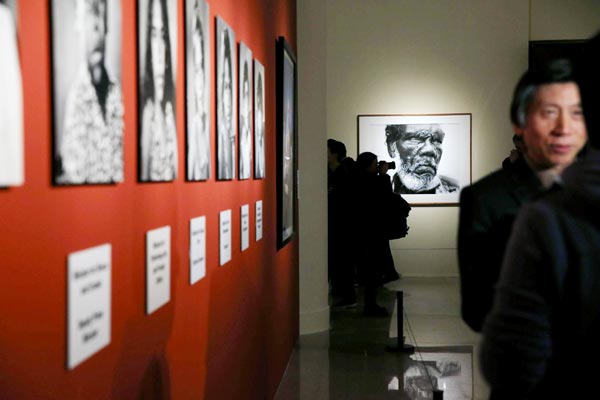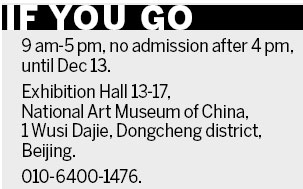Australian artist Jason Wing loves to take a stroll around Fangjiacun village, in northeast suburban Beijing, his temporary home for three months. He is a resident artist at the village's Red Gate Gallery's studio.
 |
|
The Australian art show titledMaking Changeis currently on show at the National Art Museum of China. Photo by Jiang Dong / China Daily |
He always finds it interesting and fascinating to see piles of bricks scattered everywhere. One day he couldn't help himself - he painted the Australian aboriginal flag on a wall of bricks. The next day, a construction site nearby used up those bricks as part of their building project.
He recorded the whole process with six colored photos, and named the series The Great Wall.
Wing says he drew inspiration from both his Chinese and aboriginal heritages - his grandfather originally came from Guangdong province.
"From walking the Great Wall, one feels the strength and exquisiteness of an ancient civilization," he says. "In the current quick society, one has to build fast, but the quality is not there."
The disassembled wall, together with the flag image on it, he says, is a metaphor of what has happened to traditional culture - a culture broken because of the fast pace of life. On the spot where the brick wall used to be, now stands a superstore, he says.
"You can't see the colored bricks anymore. History is buried. People make something look polished and smooth, but the real foundation is not there."
His photo series are on display at a contemporary Australian art show titled Making Change. They are among a total of 107 photos and videos exhibited at the National Art Museum of China as a testimony to the growing confidence of Australian artists, particularly indigenous artists, as well as their concerns about native cultures.
The exhibition is in response to the public's rising interests in diverse modern culture Down Under. Australia has become a popular study and immigration destination for the Chinese.
"Undoubtedly, the indigenous population has made leading contributions over the past 20 years," says Zhang Qing, director of the museum's research and curator department.
"Aboriginal and Torres Strait Islander art are now symbols of contemporary Australian art.
"The exhibition, however, departs from the approach of familiar visual traditions. But it incorporates the creative thinking of indigenous art into the context of globalization."
He says the photos and videos fully express the character of Australians, particularly indigenous residents - that they are "cheeky and outspoken, funny and subversive".
Wing says China and Australia share a very similar challenge: how to survive in a consumer-driven society.
"How to keep our culture strong and not lose our traditional connections, that's the challenges both China and Australia face."

He says it's very rare to have a real snapshot of Australia outside the country.
"It's important to get our messages out globally, because often they are kept kind of silent within Australia. It's great that we can have this international voice."
The exhibition also celebrates the 40th anniversary of the establishment of Sino-Australian diplomatic relations.
It juxtaposes contemporary works of art with historical photos of Gough Whitlam's visits to China in 1971 as the opposition leader and in 1973 as the prime minister.
The old images from the National Archives of Australian in Canberra include Whitlam's meetings with late leader Mao Zedong and premier Zhou Enlai, and also an interesting photograph of Whitlam pressing his ear on the echo wall at Beijing's Temple of Heaven.
linqi@chinadaily.com.cn
|
|
|
|
|
|
|
|
